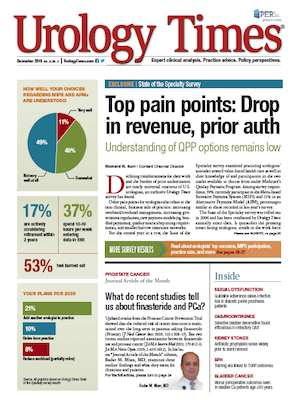Publication
Article
Urology Times Journal
Protocol cuts opioid prescribing in stone patients
Author(s):
Researchers in Tennessee are finding success with the use of an Enhanced Recovery After Surgery pathway that provides standardization for the anesthetic care and postoperative management of patients undergoing ureteroscopy and stent placement with a novel approach that minimizes opioid exposure.
Victor Moussa - stock.adobe.com

Researchers in Tennessee are finding success with the use of an Enhanced Recovery After Surgery (ERAS) pathway that provides standardization for the anesthetic care and postoperative management of patients undergoing ureteroscopy and stent placement with a novel approach that minimizes opioid exposure.
“The opioid crisis is an issue that all clinicians face, and there has been a push to decrease opioid use where feasible. Ureteroscopic stone management is a surgery where some early work has been successfully done to reduce opioid prescribing,” said first author Chad Gridley, MD, who was an endourology fellow at Vanderbilt University, Nashville, TN, at the time of the study.
Dr. Gridley and his co-authors noted that nephrolithiasis patients undergoing ureteroscopy are at a significant risk for opioid dependence due to the nature of the disease. Many of these patients are often seen by multiple providers across an acute episode, and they must undergo management for surgical and stent-related pain.
Also see: Report urges action on physician burnout
The authors evaluated the ERAS care pathway and found this protocol resulted in a reduction to almost near-zero levels of opioid prescribing. In addition, with this protocol there were fewer postoperative phone calls and no adverse effects on patient-reported outcomes, ER visits, or opioid refills.
“This ERAS protocol provides a novel, comprehensive approach to perioperative management of patients undergoing ureteroscopic stone surgery with stent placement without the use of opioids, theoretically providing a way to reduce the amount of prescription opioids within the population,” said Dr. Gridley, currently with the University of North Carolina, Chapel Hill.
The study included 80 patients (28 pre-ERAS, 52 ERAS); mean age was 53.8 years for the pre-ERAS group and 55.8 years for the ERAS group. Dr. Gridley said overall there were no significant differences in gender or age between the groups.
When using univariate and multivariable analyses, the authors found there were statistically significant differences for preoperative PROMIS 3a, postoperative PROMIS 3a, and postoperative PROMIS 6b (p<.05). The meaningful differences for these measures suggested there was no clinically significant difference on those health measures.
Next: Significant differences seen between pre-ERAS, ERAS groupsSignificant differences seen between pre-ERAS, ERAS groups
The authors found a dramatic difference in pre-ERAS and ERAS groups for the number of patients discharged with an opioid prescription (93% vs. 0%). The study showed similar good news with discharge opioid prescription dose in morphine milligram equivalents (57.9 vs. 0%) and total opioid prescription dose in morphine milligram equivalents (60.1 vs. 7.7), all of which were statistically significant (p<.05).
The ERAS protocol was very specific. It included preoperative non-opioid premedication and minimal intraoperative and post-anesthesia opioids. It also contained explicitly written non-opioid discharge medications for all patients. All the patients were contacted at 48 to 72 hours and 7 days post-op.
Read: Data from 18-year study support HoLEP’s efficacy
“We were somewhat surprised at how accepting patients were to the need for a non-opioid protocol and their willingness to participate in this new protocol. This may be due in part to how prevalent addiction is and how many people have been affected directly or indirectly by the opioid epidemic,” said Dr. Gridley.
In this study, no patients on the ERAS protocol were discharged with an opioid prescription and there were no significant differences between the traditional opioid-managed population and non-opioid ERAS protocol with regard to office phone calls for pain, ED visits, or requests for opioid refills. Dr. Gridley said even more importantly, there were no clinically significant differences on patient-reported outcome measures.
“For a significantly painful urologic condition that has traditionally been managed with large amounts of opioid medications at a time where opioid addiction and opioid overdose deaths are at an all-time high, our protocol provides a successful, non-opioid alternative method for managing patients undergoing ureteroscopic management of their stones,” the authors wrote.
We want to hear from you! Do you use ERAS protocols in your practice? Let us know at urology_times@mmhgroup.com

Newsletter
Stay current with the latest urology news and practice-changing insights — sign up now for the essential updates every urologist needs.



























